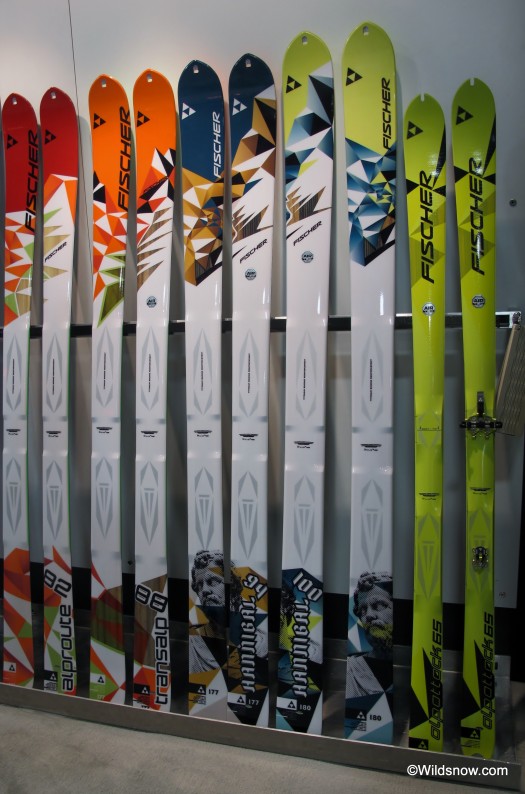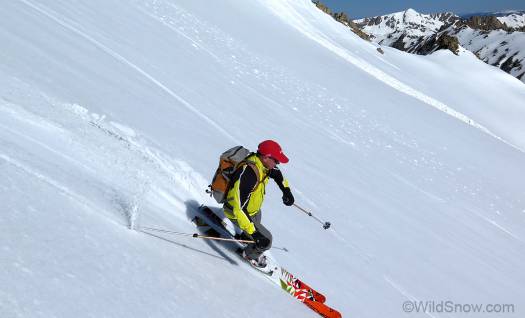Just a few weeks ago: It’s springtime here in the Colorado Rockies backcountry, which really just means it’s spring, summer, and winter — all rolled up into one. One day you may ski perfect corn, then next a foot of powder, then frozen breakable, or slurpee-esque conditions, and maybe mix in some blown-in dust as a topcoat just for fun. If you’re lucky you’ll get to hit all that in the same day or even the same line. It’s tough to find a ski that will deal with all of the above. Key word for this kind of ski is versatile, and the Fischer Transalp 88 totally fits that description.

Fischer offers quite a fleet of ski touring skis. Left to right: AlpRoute 82, 1250 grams. TransAlp 88, 1150 grams. Hannibal 94, 1250 grams. Hannibal 100, 1500 grams. AlpAttack, 650 grams.
My only experience with Fischer skis prior to Transalp had been on the nordic side of things. Somewhat irrelevant here, but for the most part they make terrific nordic skis, particularly on the higher end of that spectrum. Perhaps that translates to making quality touring skis? In any case, seems to me that Fischer is making a serious move into the ski touring and ski mountaineering market. That’s where the Transalp 88 fits in.
We’ve been testing a 177cm Transalp, as well as the Fischer Hannibal 94 throughout this season. Lou posted some initial pics and thoughts about these skis here after they arrived at Wildsnow HQ last fall.
Without restating too much what has already been said, the Transalp 88 177cm comes in at 123-88-111, has a 19m radius and weighs on average 1303 grams per ski. That’s fairly light for a backcountry ski. There seems to be an ABS sidewall, but only underfoot, and it is all this ski needs. Edge hold is stellar. Uniquely, the Transalp, like the Hannibal 94, has a nice, thinner, convex top running from the flat binding mounting area to the shovel, and back to a few centimeters shy of the tail. This reduces material and makes the ski lighter, and also helps shed snow buildup when skinning up (which works to a certain extent, but as we constantly allude to here at WildSnow, the solution to keeping snow off ski tops is still a mystery). Wetter snow still adhered to the topsheets on the up, but was definitely reduced as compared to other skis I’ve been on. Cold dry snow didn’t seem to stick at all. Nice to see an innovative approach to this never-ending problem.
The Transalp features moderate rocker. About 300mm at the tip and 140mm at the tail is what I informally measured on the test pair. Not a lot, but enough to add versatility. Skin attachment is via a small hole in the tip that utilizes a nifty “cam hook” feature (found on Fischer and K2 skins) and proved to be bomber in my testing. Tail attachment is a traditional strap/hook, and worked fine. And of course one must mention, as many have, the utterly bombproof binding mounting plate, which I think we concluded really is titanium or perhaps unobtainium. Even with a brand new bit, I struggled to drill holes in the thing. Nice piece of reassurance in my opinion though.
So question is, with all these cool features, how do the Transalps ski?
In a phrase, really well. Initial impressions were that the Transalp is a totally solid, damp, fun ski. The edgehold is impressive, important downhill, but also while skinning up: think scribing a tenuous line across frozen spring corn while pondering why you forget your ski crampons. No worry, the Transalps hold really well.
Much like an all terrain tire, I would call the Transalp an all terrain ski. They can handle a variety of conditions pretty easily, like the stuff you’ll probably encounter in the backcountry or peak skiing in the spring, without throwing you around.
The only place where I’ve been hesitant on the Transalps was in some mild sastrugi. Short, quick turns with some speed induced chattering, much like speed wobbles you’d get on a road bike. Not pleasant. But that’s been the only situation where I felt the ski was a bit out its element. Though I attribute that more to skiing a little too aggressively for the conditions.
Being a believer in wider skis for powder laps, I was hesitant to ski the Transalps in the fluff. But a test was of course necessary. Our most recent storm brought a foot or more of spring fresh to our valley. Though not a modern powder ski by any means, the Transalps skied it pretty well. The 123cm shovel with some rocker helped create some float, but not a totally surfy feel. Whether it was the drier colder powder up top, to the moister, transitioning to Sierra cement down lower, the Transalps made me, surprisingly, smile.
I’d still use a dedicated powder ski for deep days, and probably a super lightweight rig for plain ol’ uphilling, but for everything in between (especially peak skiing in the spring), the Transalp could be that ski. I’ve really enjoyed this ski on steeper lines with variable conditions, but they have been just about as much fun everywhere else.
Wanna pair? The Fischer Transalp 88 can be found at our supporter 8k Peak.
Scott lives near Carbondale, CO with his wife Jenny. He often meditates on finding that perfect career while pushing his heart rate to places it probably shouldn’t be.

